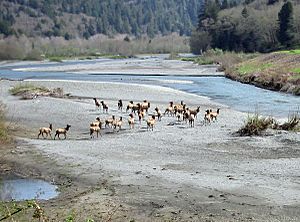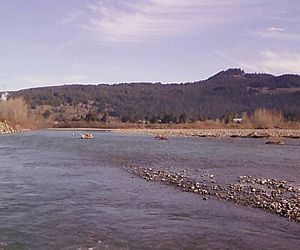Whilkut facts for kids
The Whilkut people, also known as the (Upper) Redwood Creek Indians or Mad River Indians, were a Native American tribe. They spoke a language similar to the Hupa and Chilula tribes, who lived nearby. The Whilkut lived in what is now northwestern California. Their homes were near the Upper Redwood Creek and along the Mad River. They also lived near Iaqua Butte and in the Grouse Creek area.
Whilkut Groups
The Whilkut people were divided into four main groups, sometimes called "tribelets." Each group lived in a specific area:
- The Chilula Whilkut (or Lower Redwood Indians) lived in the northern Redwood Creek area. Some experts consider the Chilula a separate tribe.
- The Kloki Whilkut (or Prairie Whilkut) were also known as the "(Upper) Redwood Creek Indians." They had about 12 villages along the Upper Redwood Creek.
- The Mad River Whilkut were called Me:w-yinaq in their language, meaning "underneath - upstream." They had about 16 villages along the Mad River, Maple Creek, and Boulder Creek.
- The North Fork (Mad River) Whilkut were sometimes called the "Blue Lake Whilkut." They had about six villages along the North Fork Mad River and near the Blue Lake area.
Some known Whilkut villages were ch'iłq'un-ding and mił-tehsch'e:-me'.
What Does Whilkut Mean?
The name "Whilkut" comes from the Hupa language. The Hupa people called the Redwood Creek area and the nearby Bald Hills Xwiy¬q'it. So, the Whilkut were known as the Xwiy¬q'it-xwe, which means "Redwood Ridge / Bald Hills People." Because they were closely related to the Hupa, they were also called the Upper Redwood Creek Hupa.
Whilkut Culture and History
Not much is known about the Whilkut culture, but it was similar to the Hupa way of life. The Hupa and Chilula tribes sometimes described the Whilkut as being private and traditional "hill people" who didn't settle in one place as much.
After gold was discovered in California, many people moved to the area. Trails used by people carrying supplies went through Whilkut land. This led to conflicts, and the Whilkut population, which was never very large, became much smaller during the Bald Hills War (1858-1864).
At the start of the war, there were an estimated 250-350 Whilkut warriors. The people who survived the war were moved to the Hupa reservation. After 1870, some Whilkut people slowly returned to their traditional homes. By 1910, only about 50 Whilkut individuals were counted in the census (a count of the population). By 1972, only a small number, perhaps 20 to 25 people, remained.
Whilkut Today
Today, many Whilkut descendants are part of the larger Hupa community. They are included in these recognized tribes:
- The Hoopa Valley Tribe in Hoopa, Humboldt County. This tribe includes Hupa, Tsnungwe, Chimalakwe, Chilula, and Whilkut people. In 2013, their population was about 3,139.
- The Blue Lake Rancheria in Blue Lake, Humboldt County. This group includes Wiyot, Yurok, Hupa, and Whilkut people. In 2010, their population was about 58.



